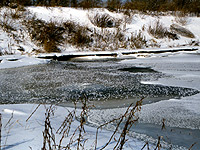Cold Evil
 Emotional cold is associated with fear in both Chinese and Western thought. Cold is associated with the element water and dominates in winter. It is a yin evil that usually injures the body's yang qi. If cold evil enters the exterior surface of the body, it produces symptoms of fever, aversion to cold, headache and body pains. If it reaches the meridians, it produces muscle cramps and pains in the bones or joints. If it enters as far as the internal organs, symptoms like diarrhea, vomiting, abdominal pains, and intestinal noises will develop. Inner-cold, again not related to external environment, is usually caused by functional deficiency of internal organs, for example in the stomach and spleen, inducing cold symptoms of nausea, diarrhea, coldness in the limbs and a pallid complexion. Excessive consumption of cold foods ("cold" in the sense of energetic or property, not temperature) can also induce cold conditions. Some examples of cold foods are water melon, mung bean, bean sprouts, lettuce, eggplant, tomato, and celery.
Emotional cold is associated with fear in both Chinese and Western thought. Cold is associated with the element water and dominates in winter. It is a yin evil that usually injures the body's yang qi. If cold evil enters the exterior surface of the body, it produces symptoms of fever, aversion to cold, headache and body pains. If it reaches the meridians, it produces muscle cramps and pains in the bones or joints. If it enters as far as the internal organs, symptoms like diarrhea, vomiting, abdominal pains, and intestinal noises will develop. Inner-cold, again not related to external environment, is usually caused by functional deficiency of internal organs, for example in the stomach and spleen, inducing cold symptoms of nausea, diarrhea, coldness in the limbs and a pallid complexion. Excessive consumption of cold foods ("cold" in the sense of energetic or property, not temperature) can also induce cold conditions. Some examples of cold foods are water melon, mung bean, bean sprouts, lettuce, eggplant, tomato, and celery.Characteristics of the Cold Evil
- Being a yin-evil, cold tends to impair yang-qi, leading to cold signs;
- It is the nature of cold to congeal and stagnate the circulation of blood and qi, leading to pain;
- It is the nature of cold to contract and shrink the affected body region, e.g. closure of skin pores, blood vessel contraction or muscular cramp.


